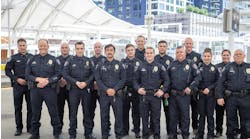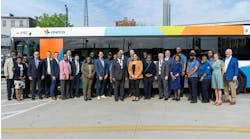Advances in technology have changed the security infrastructure used in transit. Though technology continues to evolve, no technology is perfect. Todd McGhee, president of Protecting the Homeland Innovations, LLC, and retired Massachusetts State trooper, says that the human sensor helps fill in the gaps by adding another layer of security.
"If more mass transit agencies begin to look at behavior analytics, they're going to see the benefit of increased police response and their customers — their ridership — feeling safe." He adds that it's not that we're going to stop high-risk behavior or terrorism, but it will push it away from our transit systems to keep them safe.
Establishing baselines will get the frontline staff, transit security and transit police officers to better understand the work environments. The training is designed for any person to examine thousands of people in a short amount of time to determine whether the environment is safe or someone is considered high risk based on behavior, not on the color of their skin or their religion.
Knowing daily ridership and understanding the trends is done through the identifiers: GAMA, McGhee explains. Watching for anomalies in the trends can point out a potential high-risk individual.
G: Groupings
What is the typical grouping at a given location at a given time? A grouping may be one person it may be two or three people. Typically, on the morning commute it's groups of one or two.
A: Articles
What type of articles are they carrying? During a morning commute people are often carrying briefcases or backpacks. Are they overly heavy causing an individual to change the way they walk?
M: Movement
What is the movement of the environment? Mass Transit stations are usually a fast-paced environment. If not, there may be a simple explanation but, as McGhee points out, a problem they've seen is high-risk people hide in plain site. He also says he often hears people say they're on public property and they can do what they want. Establishing that they're on private property with public use and that they need to be there for a lawful purpose is important.
A: Attire
How are they dressed? Are they dressed appropriately for the time and day and being in the facility? He stresses that it's not a crime for people to express themselves. That person with bulky, heavy clothing with unusual bulges or things that might not look right may need further interaction.
"The biggest thing with our training is the importance of preserving civil rights with security," McGhee stresses. "We want to be careful with rolling out enhanced security measures."
When it comes to tactical dialogue, it engages the patron that is considered possibly high-risk. An officer engages that individual and categorizes them as high-risk or low-risk.
Frontline staff is aware of the trends of their environment. They observe someone deviating from that baseline, they make a report, police interaction follows.
"All they're trying to determine is the validity of the person's story," McGhee explains. "They ask a customer service-oriented question. At no time is the person under arrest or feel they are unable to leave the area." As he says, it's customer service with a public safety twist.
The style of questions are designed to elicit a response and the person simply tells their story. Truthful people basically display positive behavior in a normal range, with a smooth conversation between the patron and the officer. It's not the answer that matters as much as the behaviors the person exhibits.
McGhee says the truthful person will often add more detailed information, their purpose, why they're at the facility. "Adversely, a deceptive person is prone to respond with very basic one-word responses and will try to avoid the uniform presence."
The identifiers give the officer a baseline and they can either break off the interview based on the truthful response, or they might ask for some identification, fare validation, or may warrant additional investigation, such as a bag being searched by a canine.
McGhee stresses that this proactive mindset of policing needs to come back. With advancing technology, the art of policing has somewhat diminished, but this trains the officer to engage the public. And, he adds, the second prong is utilizing and leveraging the resource of the frontline employee as the human sensor that is capturing this anomaly. Frontline staff gets trained on what to report and how to report.
One pushback that McGhee has seen is with the personality of the officer, for example if they are more of an introverted personality. Once ice breaker-type questions have been established and they can get past that, it's a smooth interaction.
He also says that with this type of training, they're not looking for a level of anxiety and hysteria. He talks about when the Anthrax scare was a concern after 9/11, anytime there was a white substance found there were evacuations, SWAT teams were called in, bomb squads were called in; there was hypervigilance.
"Our goal is not just to educate, but a level of education so employees and officers are making professional, trained guesses to vet out a person that's high risk."
McGhee says their curriculum was approved by the Department of Homeland Security in June of 2007 and part of the technique is the tactical dialogue. He sums up what they do by saying, "We believe in educating the human sensor — the frontline staff and transit police — in understanding human behaviors."


